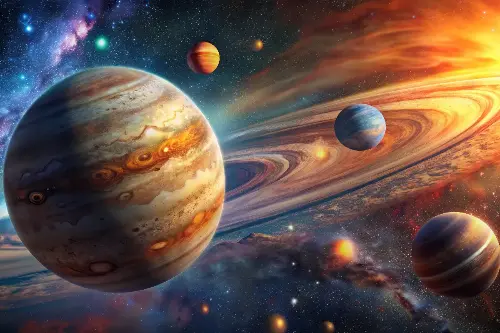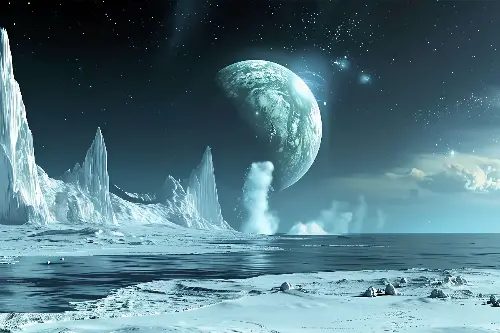As we venture through the cosmos, the planets of our solar system are often the stars of the show with their grandeur and size. However, orbiting these planets are smaller bodies, moons with fascinating tales to tell and wonders to reveal. These natural satellites are more than mere rocky companions; they are worlds of intrigue, brimming with unique features and storied pasts.

The Moon: Earth's Trusty Companion
Our very own moon has a gripping story, born from an ancient and colossal impact with Earth. This celestial dance between rock and gravity has culminated in the only extraterrestrial body humans have set foot on. The moon's surface, scarred by countless craters and basins, tells a history of cosmic bombardment. Its synchronous rotation, always showing the same face towards Earth, exhales a sense of familiarity and mystery alike.
Titan: Saturn's Earth-like Moon
Beyond our home, there lies Titan, Saturn's largest moon. Enshrouded in a thick, nitrogen-rich atmosphere, this moon is a captivating spectacle. It's the only place beyond Earth where you can find liquid in stable bodies on the surface—but not water as we know it. Instead, Titan's rivers, lakes, and seas are composed of methane and ethane. With its complex weather systems and geological processes, Titan is a prime candidate for studying prebiotic chemistry.
Io: Jupiter's Volcanic Powerhouse
Jupiter's moon Io presents a stark contrast. The most geologically active body in the solar system, Io is a volcanic wonderland. Its surface is dotted with hundreds of volcanoes, some erupting lava fountains up to 400 kilometers high. These fiery features are a result of the intense tidal forces exerted on Io by Jupiter’s immense gravity. This constant flexing generates heat, keeping Io's interior in a perpetual molten state.

Europa: An Ocean World
Also orbiting Jupiter is Europa, a moon that harbors a secret beneath its icy exterior: a global ocean. Encased within a shell of ice, this deep saline ocean might host more than twice the water of Earth's oceans. The intrigue of Europa lies in its potential for harboring life, with NASA planning missions to explore this icy moon further. Its extraterrestrial ocean is a focal point for astrobiologists and dreamers wondering what creatures, if any, may lurk within its dark depths.
Enceladus: Saturn's Snowy Surprise
Saturn’s moon Enceladus is a dazzling world with its bright, highly reflective ice-covered surface. Its south pole features geysers that eject vast plumes of water vapour and ice particles into space, hinting at another subsurface ocean. These plumes are loaded with organic compounds, suggesting a hydrothermal activity at the ocean floor that could potentially sustain life.
Triton: Neptune's Captured Moon
Venturing out to Neptune, we find Triton, a moon that likely didn’t form around the blue giant. Thought to be a captured Kuiper Belt object, Triton orbits Neptune retrograde - the opposite direction to the planet’s rotation. With geysers that spout nitrogen ice and a remarkably young and smooth surface, Triton destroys the old to create the new. Its past is distinct and violent, a testament to the dynamic nature of moon formation.

Phobos and Deimos: Mars' Mysterious Twins
The two moons of Mars, Phobos and Deimos, present another peculiar pair. These small, irregularly shaped bodies are thought to be captured asteroids, and their appearance is starkly different from our own moon. Phobos, the larger and closer of the two, exhibits a network of grooves and lines, whilst Deimos is smoother but deeply cratered. Interestingly, Phobos is gradually spiraling towards Mars, with the expectation of eventually crashing into the planet or breaking up to form a ring system.
Charon: Pluto's Companion in the Darkness
Charon, the largest moon of the dwarf planet Pluto, is exceptional in that it's half the size of Pluto itself. This duo is more like a binary system than a planet and moon. Charon’s most striking feature is a massive canyon system that stretches across its surface, far longer and deeper than the Grand Canyon. Amid the shadows, Charon’s stark features speak to a complex and violent past that scientists are only beginning to understand.
These entrancing tales of our solar system's moons shed light on the incredible variety and dynamism of our celestial neighbourhood. Each moon tells its story, not just of geology or astronomy but of the unfathomable forces and events that continue to shape our understanding of existence within the cosmos. As our technology and curiosity propel us forward, the moons of our solar system remain as some of the most intriguing destinations in our collective journey to comprehend the universe we inhabit.
